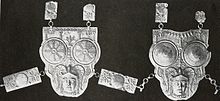Ksour Essef cuirass


The Ksour Essef cuirass is a Hellenistic gilded bronze cuirass which was found at Ksour Essef in Tunisia. It is now kept in the Bardo National Museum in Tunis.
Description
The cuirass consists of two parts: a breast plate and a back plate. It is similar to the triple-disc cuirass, of which it is a further development. On the breastplate, there are two discs which extend slightly from the surface of the breastplate in order to provide space for the muscles of the wearer's breast. The lower part of the plate is not the same as the triple disc cuirass, instead it depicts the helmeted head of Athena. The back plate is similarly shaped and the connecting plates are richly decorated too. On the discs, around the head and between them there are foliage and tendril motifs. The breastplate closed around the body with chains at the waist (supplemented by leather bands) and was secured over the shoulders by bronze hinges.
History
The breastplate was discovered in February 1909 in a grave in Ksour Essef in modern Tunisia, within the realm of ancient Carthage. It dates to the 3rd century BC. It was definitely not created in a Carthaginian workshop, but in a bronze smithy in Campania which was a centre for this sort of work in the third century. Perhaps a soldier of Hannibal acquired the armour as booty and willed that it be buried with him at his death - counter to common custom in Carthage at the time.
Bibliography
- Alfred Merlin. "Découverte d'une cuirasse italiote près de Ksour-Es-Saf (Tunisie)." In: Monuments et mémoires de la Fondation Eugène Piot 17, 1909, pp. 125–137 (Full Text). (French)
- Gilbert & Colette Picard. Karthago, Leben und Kunst. Reclam, Stuttgart 1983, ISBN 3-15-010316-9, p. 205 Taf. 25.
